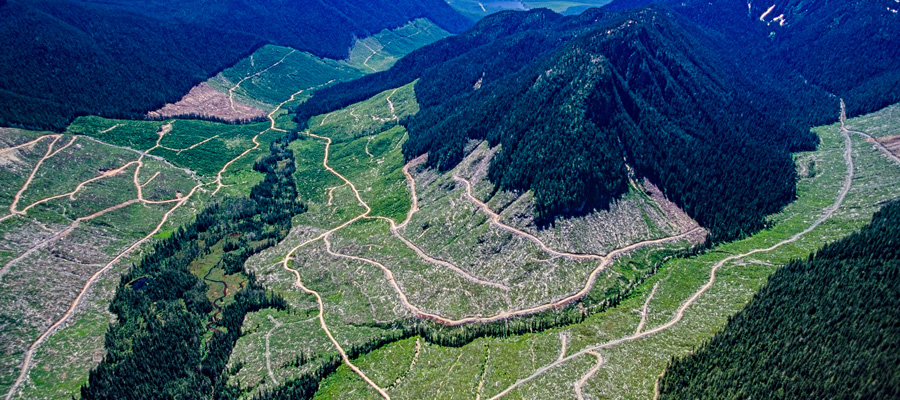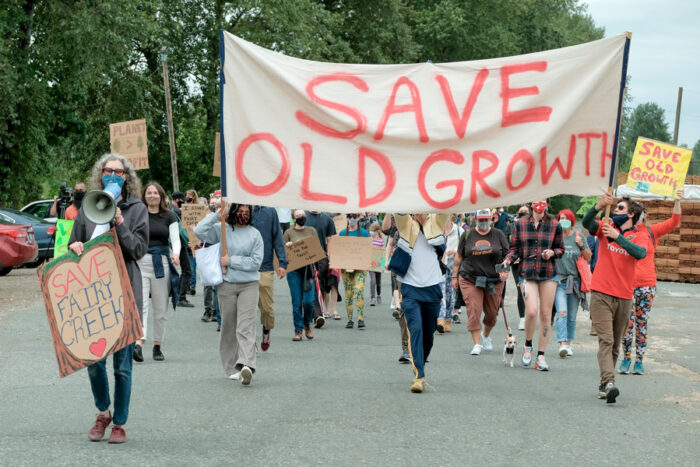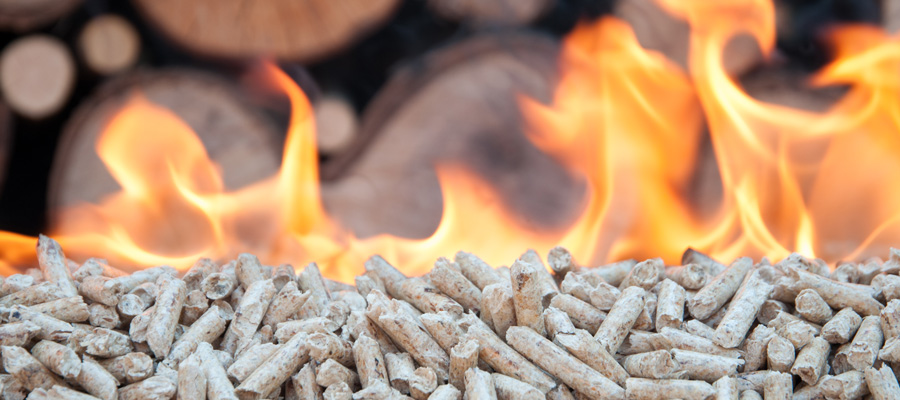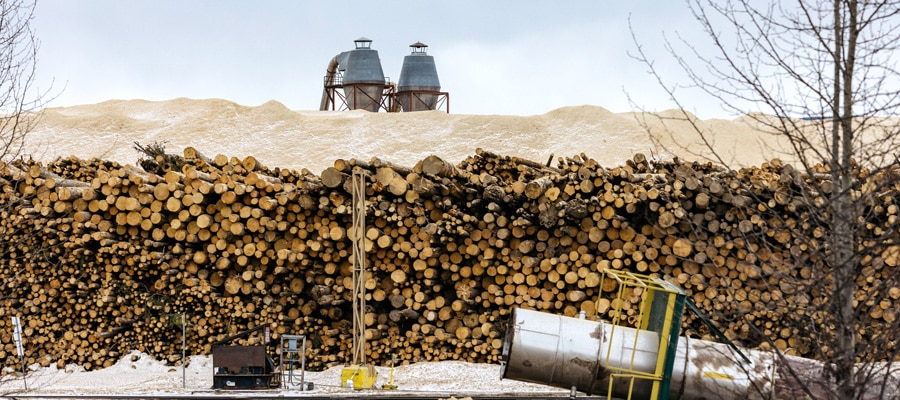The last of the green gold: With the best trees gone and revenues plummeting, what’s next?

Last year, as hundreds of protesters were arrested at Fairy Creek on Vancouver Island for trying to stop logging of old-growth forests, the BC government raked in more money from companies doing such logging than at perhaps any point in history.
In total, it collected more than $1.8 billion dollars in stumpage fees—a number that would have been higher still but for the protests.
Nothing in the past 15 years comes remotely close to that revenue benchmark, a figure that underscores that it is not just the logging companies who benefit financially from logging old-growth or primary forests, but the provincial government as well.
New research by the CCPA–BC shows, however, that the whopping stumpage revenues of last year mask trouble ahead. The high revenues were only made possible by an unprecedented run-up in lumber prices and the extraordinary value of the older trees that are the chief target of BC logging companies.
With those trees disappearing as quickly as Newfoundland’s cod once did, the provincial government belatedly announced last year that it would defer logging in a portion of remaining old-growth or primary forests for two years, pending negotiation with affected First Nations.
The fear now is that the government’s deferral announcement will be scapegoated as the cause of a coming crash in logging rates, as opposed to government forest policies that encouraged both the rapid depletion of BC’s once-bountiful old-growth forests and the production of low-value forest products that put few people to work.
“The proposed deferrals have become the bogeyman, not the industry’s over-cutting, or its exports of raw logs, or the undisclosed huge number of logs being consumed by wood pellet mills—a forest and job killer if ever there was one,” says Torrance Coste, national campaign director for the Wilderness Committee.
And we all fall down
The long predicted “falldown effect” is here: logging rates are plummeting as old-growth or primary forests never before subject to industrial logging disappear.
Many rural communities—Indigenous and non-Indigenous alike—have paid the price for that. The forests nearest to them are long gone. Local mills have closed. Many more soon will. Meanwhile, the prognosis for forest ecosystems is dire, with some globally rare forest types like the interior rainforest now so depleted that they are on the verge of ecological collapse. The fear now is that the government’s deferral announcement will be scapegoated as the cause of a coming crash in logging rates.
“Canfor’s obviously seen the writing on the wall. If the worst is to be avoided, we need to scale back the number of trees logged and then do everything we can with the wood from those trees,” says Scott Doherty, executive assistant to the national president of Unifor, the largest private-sector union in Canada, and one of three unions representing forest industry workers in BC. “But we see no sign that the government is serious about making that happen. Millions of trees continue to be cut down every year, only to be shipped as raw logs to China, Korea and Japan. And millions more are cut down simply to be turned into wood pellets, in one of the lowest value, poorest job-generating enterprises of any in the forest industry.”
The monster year that was
To arrive at its numbers, the CCPA used a searchable government database to look at logging rates and stumpage revenues over the 15 years ending in 2021. The analysis shows that last year’s whopping stumpage revenues happened even as logging rates were falling. Typically, declines in logging should correlate with declines in revenue. But last year things were flipped on their head. Why?
In a nutshell, much of it traces to COVID. As the global pandemic spread and people isolated at home, those with means plowed money into renovations or purchased new homes, which sent lumber prices soaring to record highs.
Since stumpage payments—the money companies pay to the government when they log trees on “Crown” or public lands—are pegged to markets, it was only a matter of time before the government’s stumpage account swelled to its heady height.
The more than $1.8 billion in stumpage fees collected by the province in 2021 ended up being $600 million more than the next closest year, which was 2018, the only other year in the timeframe examined by the CCPA when stumpage revenues exceeded $1 billion.
But the kicker in 2021 was that the $1.8 billion in revenue was generated on the logging of roughly 58.2 million cubic metres of trees. In 2018, by comparison, logging companies cut down 70.7 million cubic metres of trees, while paying $1.2 billion in stumpage. In other words, last year the government collected 50 per cent more in revenues than the previous highest year even though Canfor and other companies logged nearly 20 per cent fewer trees.
This takes on added significance when looking at what kind of trees the logging companies cut down the most. The data analyzed by the CCPA shows clearly that in recent years, the majority of trees logged were of the highest quality—an indication that the industry, with the government’s encouragement, targeted the healthiest older forests for logging, leaving behind not only fewer but more impoverished forests. Last year the government collected 50 per cent more in revenues than the previous highest year even though Canfor and other companies logged nearly 20 per cent fewer trees.
Those price premiums translate into higher stumpage revenues, which the government in turn channels into various programs and services including healthcare and education.
Logging rates halved in just 15 years
The monster revenues of 2021 won’t be repeated, and the government has admitted as much in its recent budget documents, saying that forestry revenues will fall by nearly 40 per cent this fiscal year due to declines in “historically high” lumber prices.
But it’s what the government says next that is more crucial. While lumber prices are projected to decline, what’s really heading south is logging rates, which have already dropped off significantly from their levels of just a few years ago.
According to the provincial budget, logging rates will fall to 39 million cubic metres annually within three years. That, according to the data analyzed by the CCPA, would mean a near halving of the logging rates recorded 15 years ago.
What the budget document doesn’t do, however, is level with the public about the kind of logging that has taken place in recent years, where the biggest revenues were generated, and what that says about what remains of our forests.
A hollowed out coast and a hollowing out interior
Because of BC’s size and spectacular diversity, the CCPA also looked at logging in each of the three big regions in the province—the coast, which includes everything from the coastal mountain ranges west to the ocean and all of Vancouver Island and Haida Gwaii, and the northern and southern interior regions, which are divided by a line that bisects the province east to west roughly near the community of Quesnel.
For more than a century, the coast with its treasure chest of massive and ancient cedar, spruce, Douglas fir, hemlock and other trees was the economic driver of BC’s forest industry. But that chest has been looted. Most of what remains is either smaller old-growth trees in higher, more remote terrain or, increasingly, second-growth and third-growth trees. As a result, the coast is no longer the driver of industry profits and stumpage revenues it once was.

Forest companies say a government decision to defer logging in certain old-growth forests will cause massive job losses. Conservationists say over-cutting is to blame. Photo credit: Blake Elliot/Shutterstock.
Complicating matters, the coast has large tracts of privately owned forestland. Trees logged on private lands as opposed to public lands are exempt from stumpage charges. As a result, the biggest private forestland owners tend to take advantage of the lower costs by loading millions of raw, unprocessed logs into the holds of ocean freighters and shipping the logs offshore rather than making investments in local sawmills to do the processing. In some years, as much as a third of everything logged on the coast was exported in raw log form, which fueled profits for a notable few logging companies such as TimberWest and Island Timberlands, but at the expense of thousands of foregone domestic manufacturing jobs.
The vast northern and southern interior regions are different from the coast in numerous ways. A big difference is that industrial logging in the interior regions only really gathered steam 50 years ago and everything logged since has effectively been in old-growth or “primary” forests where industrial developments had not previously occurred. Privately owned forestland in the interior is also negligible, which means far fewer log exports. In some years, as much as a third of everything logged on the coast was exported in raw log form.
The logging of these rarest of rare forests has accelerated dramatically in the past decade, particularly as highly inflated and unsustainable “salvage logging” in other pine beetle-ravaged areas declined because the industry had either effectively logged out such forests or the trees that remained had lost too much economic value following the beetle attack.
These differences are important because as economically accessible old-growth forests have been logged out of existence on the coast, more and more industry profits and government revenues have come from logging the interior’s primary forests.
In the past fifteen years, there was only one year (2008) when stumpage fees paid on the coast exceeded those in the southern interior. Moreover, in the last 10 years, stumpage revenues in both the northern and southern interior always exceeded those on the coast, often by a wide margin.
Last year’s monster stumpage revenues are a case in point. The regional breakdown shows that:
- Logging in coastal forests tipped the scales at more than 15 million cubic metres and generated nearly $286 million in stumpage payments, for an average per-cubic-metre payment of $18.60.
- In the northern interior region, by comparison, 23 million cubic metres was logged, generating stumpage payments of $727 million, for an average of $31 per cubic metre.
- And in the southern interior region, the logging exceeded 19 million cubic metres, generating nearly $800 million in stumpage payments, for an average of $41 per cubic metre.
Feasting on the best wood
In the interior regions where some of the biggest sawmills in the world operate, the top quality logs that are the raw feedstock for the best lumber are designated as Grade 1 or Grade 2 logs.
Such logs generally come from older trees that are healthy and alive before they are cut down. Such trees also have typically fewer defects such as checks, cracks or knots, and have sustained minimal to no damage from tree diseases or insect attacks. These logs generate higher stumpage charges than lower quality logs.
In the last five years, the Grade 1 and Grade 2 logs coming out of the interior’s primary forests constituted 57 per cent of everything logged, while generating 82 per cent of all the stumpage fees paid, a clear sign of their value to the region’s big lumber producers, like Canfor, which last year posted a record $1.5 billion in net earnings.
These outcomes matter, because as anyone paying attention knows, the forests in BC’s interior regions have been hammered by intense infestations of mountain pine beetles and other insects as well as tree-destroying blights, droughts and intense wildfires, leaving behind a land base depleted of much of its commercially attractive trees.
Yet in the face of growing scarcity, Canfor and others somehow managed to find the best possible stands of remaining trees to log. And the government helped make that happen, through an obscure subsidy program known as “crediting,” a program that the CCPA dissected last year in The Great Tree Robbery.
“Perverse subsidies”
Now in its 17th year, the crediting scheme works like this:
Companies that deliver “lower quality” logs from forests to wood pellet mills or pulp mills can apply to the government for credits that allow them to go back into the forest and log an equivalent volume of trees again.
This is a big incentive because the companies that obtain the credits for delivering lower quality logs can then go back into the forest a second time to get even more of what they really want, which is the higher quality Grade 1 and Grade 2 logs from primary forests. Canfor and others somehow managed to find the best possible stands of remaining trees to log.
However, some documents hinting at the subsidies’ impacts do exist. One government publication notes that in the Prince George area alone, over just one five-year period, an additional 2.4 million cubic metres of trees were logged as a result of the program.
Under the credit scheme, the government has also told the logging companies that the bonus logging is effectively off the books. It falls outside the tallies used by the province to limit what logging companies can cut down, something known as the Allowable Annual Cut (AAC).
Herb Hammond is a professional forester and longtime advocate of ecosystem and conservation-based forestry, which allows for some low-impact selective logging while leaving behind forests that continue to function much as they would had no logging taken place. Hammond says the credit scheme has propped up a house of cards and that there will be an inevitable crash, as he and others predicted decades ago.
“Government and timber companies, aided and abetted by forest professionals in their employ, have overestimated a sustainable rate of cut and focused on progressive high-grading of remaining old-growth and other primary forests. Perverse subsidies like the ‘log credit’ program only postpone the inevitable. The only winners in this Ponzi scheme are corporate timber companies, who are collecting the last of the gold from BC’s forests on their way out the door to fast-growing tree plantations elsewhere,” Hammond wrote when details of the subsidy program were revealed late last year.
The Science Alliance for Forestry Transformation, a group of top forest ecologists who joined forces in 2021 to “debunk myths” and provide information on alternative, more ecologically sound approaches to forestry in the province, recently co-released a video with the CCPA that explains the origins of the credit program and how, in particular, it has fueled a troubling growth in the wood pellet industry, which has increased its output fourfold since the credit scheme began. The only winners in this Ponzi scheme are corporate timber companies.
“The pellet industry in BC is set to expand in a big way,” Connolly warns in the video. “And the only way they can do it is if the BC government continues to allow the logging of primary forests for this purpose. And this has to stop.”
The old-growth blame game
To understand the coming crash it helps to go back to events in the interior regions in the early 2000s when an epic infestation of mountain pine beetles killed hundreds of millions of lodgepole pine trees, briefly becoming front-page news in the province.
The government encouraged the logging industry to cut down as many of the attacked trees as possible so that the companies and government alike could reap a short-lived economic windfall by “salvaging” them before they lost their value.
At its height, the inflated logging rates approved by the government allowed the companies to cut down an additional 11 million cubic metres of trees per year. The CCPA estimated in 2005 that the increased logging over time could see an additional 63 million cubic metres of trees logged, enough wood to fill a line of logging trucks lined bumper-to-bumper from Vancouver to Halifax five times over. .
The consequence of the decision to turbocharge logging rates is the falldown effect. Primary forests were cut down too quickly, and now there is a looming “mid-term timber supply” problem—government and industry jargon for a shortage of trees.

A wall of logs await conversion to wood pellets at a mill in Houston, BC. Photo credit: Stand.earth.
The only way to prop up logging rates today is to hammer away at what little primary or old-growth forests remain. But doing so guarantees an impoverished future where forest ecosystems are badly damaged or destroyed and there are few options to log, let alone manufacture forest products, where the bulk of job opportunities lie.
Complicating matters is the provincial government’s belated decision in November to defer the logging of 2.6 million hectares of at-risk old-growth and primary forests. The government said the decision could eventually lead to outright protection of those forests, but that will depend on consultation with affected First Nations. Primary forests were cut down too quickly, and now there is a looming shortage of trees.
The deferral decision pleased no one. And the CCPA, along with conservation, union and First Nation leaders said as much at the time.
The Council of Forest Industries (COFI) immediately warned of economic carnage, claiming that 18,000 jobs were at immediate risk—a claim it did not support with any backing documentation of how much logging rates would fall or where the biggest declines might be. COFI also did not specify whether its projected job losses were direct jobs only or also spinoff jobs. The most recent BC labour market statistics show that there were 56,000 direct forest industry jobs in the province in 2021.
Katrine Conroy, Minister of Forests, Lands, Natural Resource Operations and Rural Development, presented a much lower but still humbling projection of 4,500 jobs lost. She, too, did not elaborate on how she arrived at her number.
On the environmental side, organizations that had long campaigned to protect remaining old-growth and primary forests pointed out that deferrals are just that. Outright protection may or may not occur down the road.
Meanwhile, many of the most at-risk older forests will continue to be logged, with the industry claiming that any limitation will have catastrophic consequences.
Consent by coercion
Placed squarely in the hotseat in all of this are the First Nations on whose traditional lands all of the logging to date has taken place—sometimes with the active involvement of First Nation members and businesses and sometimes not.
After the deferral announcement on November 2 of last year, the government gave First Nations just 30 days to respond to specific deferrals proposed on their traditional lands. When that month came to an end, the Union of BC Indian Chiefs condemned the process and decried the untenable position the government had placed First Nations in. The deferral decision pleased no one.
“The Horgan government is abdicating its responsibility to protect old-growth, is pressuring First Nations into making critical decisions regarding the territories and forests they have stewarded over since time immemorial and is continuing to deny the fact that they must immediately provide substantial resources to support First Nations towards this goal—this is consent by coercion.”
Predictably, the doomsday numbers advanced by COFI and the general lack of enthusiasm with which the government’s old-growth deferral decision was received were grist for the mill for media pundits following the release of the provincial budget document.
In his reporting, post-budget, Black Press’s Tom Fletcher wrote:
“Projections in Tuesday’s BC budget show a decline in provincial revenue from timber cutting, from $1.8 billion in the current year to $1.1 billion in 2024-2025. The drop is mainly as a result of province-wide deferrals of harvesting in areas identified as rare and threatened old-growth forests, Finance Minister Selina Robinson said Feb. 22.”
But a read of the budget document itself reveals that the primary reasons for the staggering revenue declines are an entirely predictable cooling off of over-heated lumber markets and a relentless decline in logging rates that “includes” projections associated with old-growth logging deferrals, which may or may not happen.
To suggest that responsibility for the downfall ahead lies solely with the government’s decision to defer logging of some old-growth forests pending negotiation with First Nations is a gross mischaracterization.
In 15 years, logging rates have fallen 25 per cent. In three more years, they will be nearly half of what they were in 2007, and only some of that coming decline will “include” the impacts associated with old-growth deferrals.
We have stripped our forests of much of their green gold. Government subsidies have encouraged that tragic outcome. And the long-predicted decline has begun.
Topics: Economy, Employment & labour, Environment, resources & sustainability


